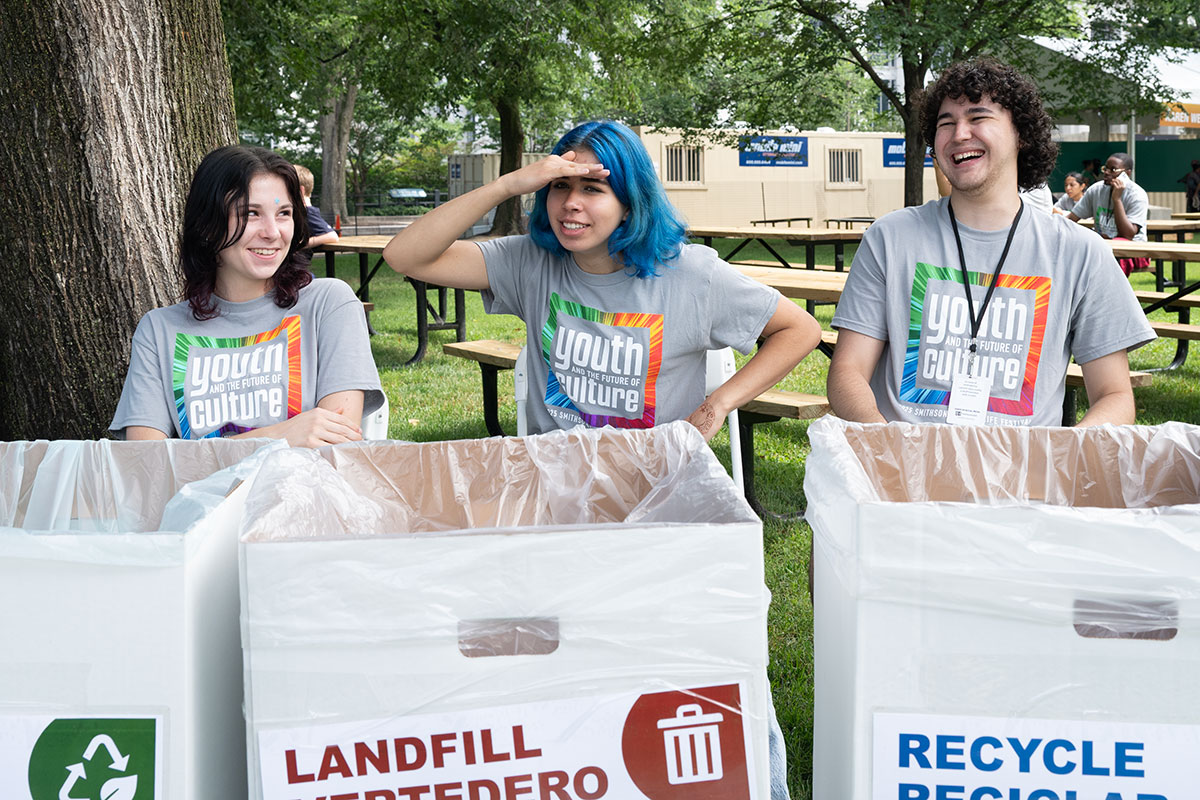Youth and the Future of Sustainability: Resource Recovery at the Festival

Sustainability volunteers at the 2025 Smithsonian Folklife Festival
Photo by Mark Roth, Ralph Rinzler Folklife Archives
How much garbage did you produce today?
Every day, 1.3 billion plastic water bottles are used around the world. That’s just one example of single-use plastic—it does not include all the candy wrappers, fast-food packaging, shopping bags, and coffee stirrers that most people encounter in their daily lives. Every day, we produce more waste. That also means that every day, environmentally sustainable practices become more relevant.
Sustainable practices have long been important at the Smithsonian Folklife Festival, but this year’s theme particularly highlights their urgency.
At this Folklife Festival, the needs of young people are front and center. The theme, Youth and the Future of Culture, centers on the experiences and goals of young people. For most young people, those experiences include environmental sustainability concerns, and the future can often look grim.
Sustainability practices and their importance to youth are a primary focus of Kate Haas, the Festival’s sustainability coordinator. She and sustainability assistant Jessie Tabella work to ensure that the Festival is as environmentally sustainable as possible. They are not alone in doing the work, though.
“We have a really big volunteer program,” Haas says. “Last year we had over fifty volunteers. They range, really, from ages twelve to eighty, but I would say the biggest portion of our volunteers are in high school. It’s definitely a very youth-involved program.”
The Festival’s volunteer involvement reflects broader trends of interest in sustainability. Across the United States and around the world, young people are afraid for their environment. Studies show that environm ental concerns can place a heavy psychological burden on young people, especially when they experience climate events like flooding, but taking action to protect the environment can sometimes help alleviate these anxieties.

The involvement of youth in environmental sustainability efforts is significant. Their passion for the issue is clear even in local settings, like the Folklife Festival. Volunteers are an essential part of the sustainability program, and without them, the Festival wouldn’t be able to achieve the success it has had with sustainable efforts.
The Festival has incorporated sustainable practices for many years. A new sustainability feature was introduced in 2011: stations for filling reusable water bottles. The current sustainability program began in 2013, when 74 percent of the Festival’s waste was diverted from landfills to composting. Today, the sustainability program continues to focus on waste diversion and resource recovery.
“If we take the time to separate, we can actually extract quite a bit of resources from what we would see as just waste,” Haas says. “We do that through compost and recycling.”
The sustainability team recently toured the recycling facility which processes the Festival’s waste and saw how recyclable materials are sorted mechanically and manually. The compost goes to a commercial composting facility, where waste is heated and aerated until it’s broken down into soil, then sold to farms.
In the years following the 2013 Festival, waste diversion improved to the point that in 2016, the diversion rate was 97 percent, earning the Festival the American Alliance of Museums’ Sustainability Excellence Award. The COVID-19 pandemic pushed the Festival online, and the following years were a period of rebuilding for the Festival and its sustainability program. Last year, the diversion rate recovered to 90 percent: 31,610 pounds of waste diverted from landfills. Haas’s goal this year is to maintain or exceed that rate. In future years, she hopes to continue the high rates of waste diversion, as well as partner with local groups to repurpose discarded materials.
To achieve this year’s goals, the Festival provides resource recovery stations around the grounds, staffed by volunteers. All containers and utensils from the Festival concessions are either recyclable or compostable, so the only waste that the Festival sends to the landfill will be brought in from outside.

So how can visitors to the Festival help reach the goal of 90 percent waste diversion?
Haas’s advice: “We encourage visitors to use our resource recovery stations. We have hopefully two or more volunteers staffing every station, and they’re really knowledgeable. They’ll help you sort your waste, and if you don’t feel like sorting it, they’ll do it for you. They have a lot of information on our program and composting and recycling in general that they can share.”
Among the sustainability program’s newest initiatives is partnering with Plugged In: D.C.-Area Community Resources Fair. Located in the Smithsonian’s Arts + Industries Building during the Festival, the resources fair highlights local youth organizations and communities for visitors who want to get involved. One of the fair’s participants is the Student Conservation Association, an organization which offers paid conservation jobs for high school students and young adults in the area.
Organizations like the Student Conservation Association, much like the volunteers at the Festival, show how important sustainability is to youth. While young people may be the most likely to be affected by the climate crisis, they are not only victims. They’re also passionate, effective people working hard to protect the environment.
Ella Peters is an intern in the Festival’s Storytellers Workshop and a rising senior at Georgetown University studying anthropology and government.

